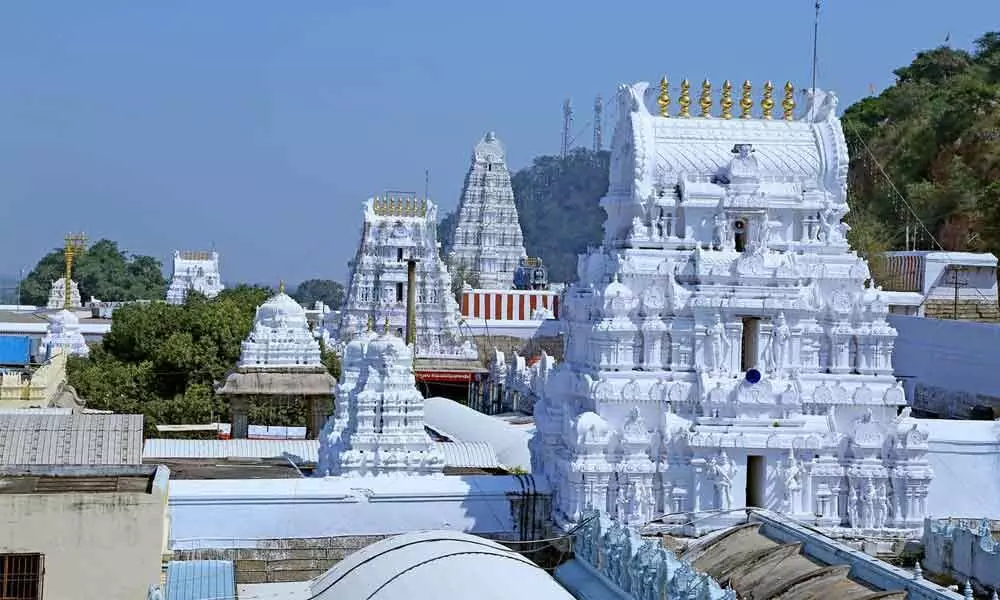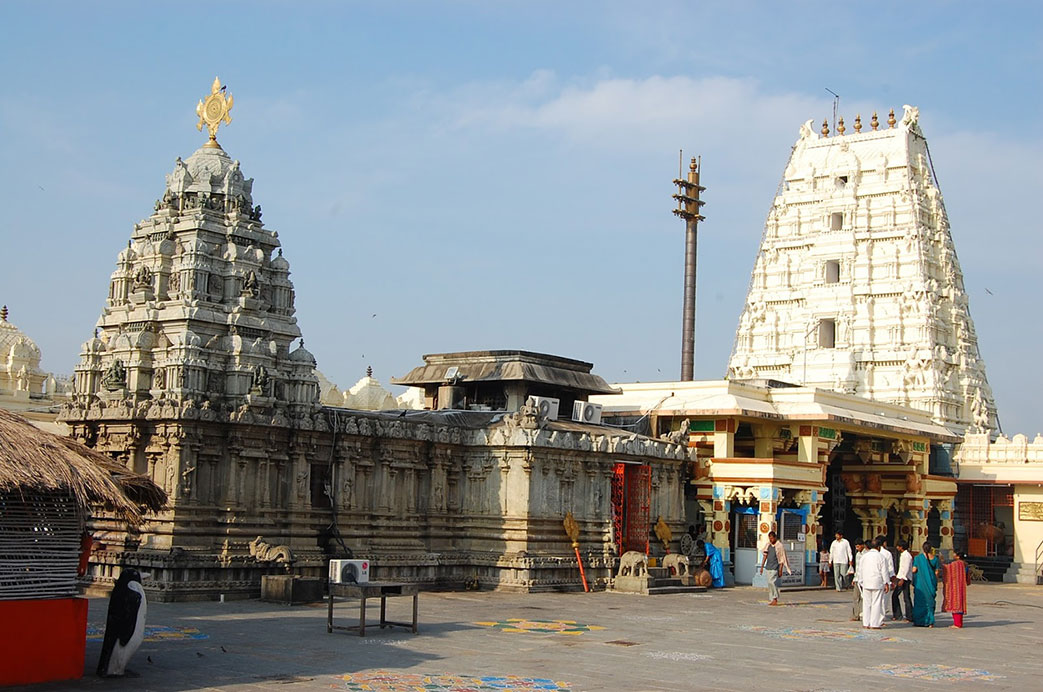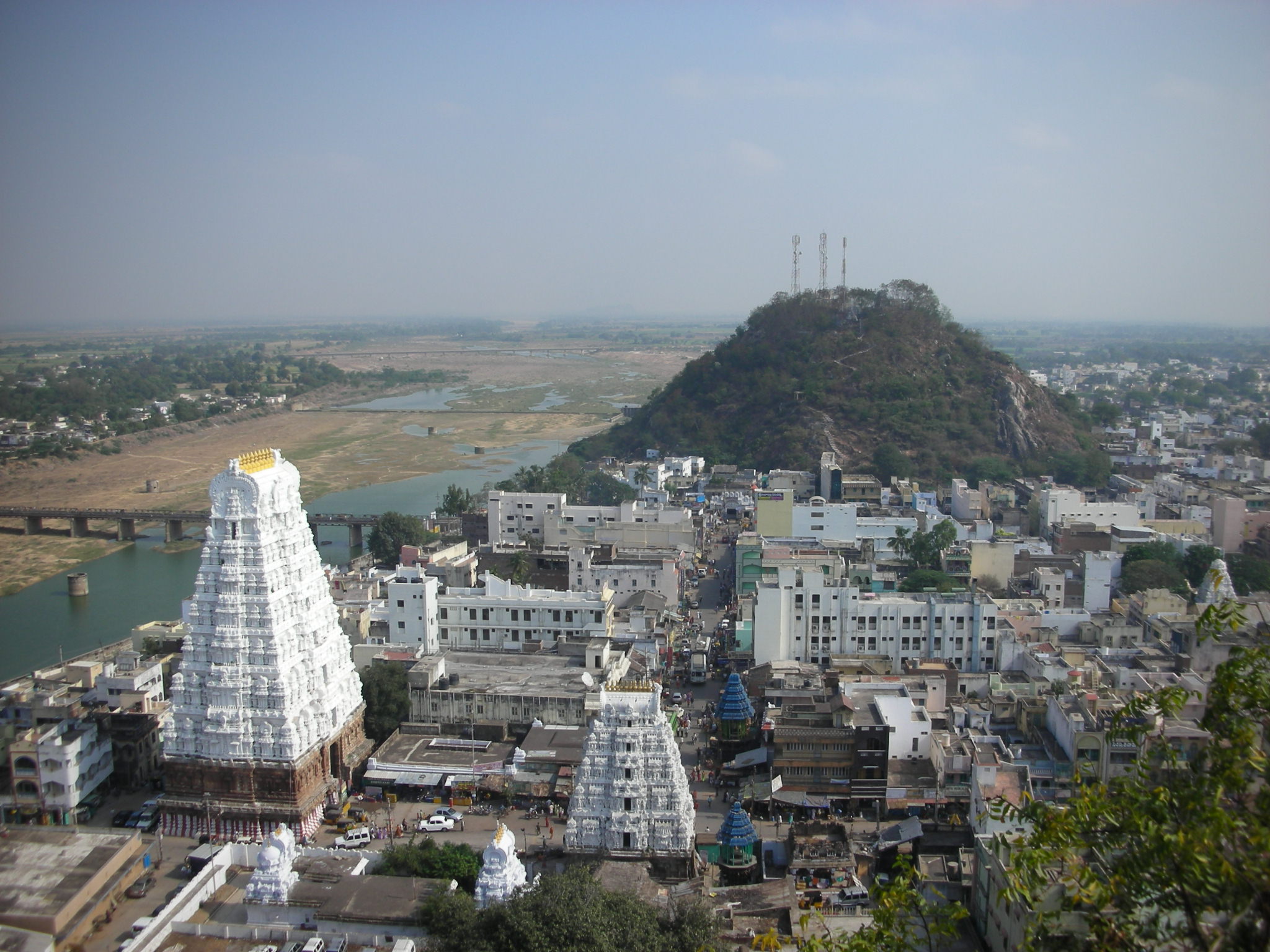Srikalahasti Temple is located in the town of Srikalahasti, in the state of Andhra Pradesh, India. It is one of the most famous Shiva temples in South India, and is said to be the site where Kannappa was ready to offer both his eyes to cover blood flowing from the Siva linga before the Lord Siva stopped him and granted him mukti. Srikalahasti temple, situated 36 km away from Tirupati is famous for its Vayu linga, one of the Panchabhoota Sthalams, representing wind. The temple is also regarded as Rahu-Ketu kshetra and Dakshina Kasi. The inner temple was constructed around 5th century and the outer temple was constructed in the 12th century by the Chola kings and the Vijayanagara kings. Lord Shiva in his aspect as Vayu is worshiped as Kalahasteeswara. The 120 feet (37 m) high main gopuram and the 100 pillar mandapam were constructed by Krishnadevaraya, the Vijayanagara king in 1516. The presiding image of Shiva in the form of Linga is made of white stone in a shape resembling trunk of elephant. The temple faces south, while the sanctum faces west. The temple is located on the foothills of a hill, while there is also a belief that the temple was carved out of a monolithic hill. There is a rock cut shrine of Vinayaka, 9 ft (2.7 m) below the ground level. Vallaba Ganapathi, Mahalakshmi-Ganpathi and Sahasra Lingeswara are some of the rare images found in the temple. There is a large shrine of Jnanaprasanammba, the consort of Kalahatisvara. There are smaller shrines in the temple for Kasi Viswanatha, Annapurna, Suryanarayana, Sadyoganapathi and Subramanya. There are two large halls namely Sadyogi Mandapa and Jalkoti Mandapa. There are two water bodies associated with the namely, Surya Pushkarani and Chandra Pushkarani. This temple is considered “Kailash of the South”. Saivaite saints of the first century sang about this temple. This is the only temple in India which remains open during Solar and lunar eclipses, while, all other temples were closed. This temple is famous for Rahu-Kethu pooja. It is believed that performing this pooja will ward the people from astrological effects of Rahu and Kethu. Appar, Sambandar and As per Hindu legend, Kalahatisvara was worshipped at this place by Brahma during all four Yugas. Arjuna, the Pandava prince during Mahabharata is believed to have worshipped the presiding deity. The legend of Kannappa Nayanar, who was a hunter and turned into an ardent devotee of Shiva accidentally, is associated with the temple. The temple also finds mention in the works of Nakeerar and the Nalvars, namely, Appar, Sundarar, Sambandar and Manickavasagar in the canonical works of Tirumura. As the temple is revered in Tevaram, it is classified as Paadal Petra Sthalam, one of the 275 temples that find mention in the Saiva canon. The temple follows Saivite tradition. The temple priests perform the pooja (rituals) during festivals and on a daily basis. The temple rituals are performed four times a day: Kalasanthi at 6:00 a.m., Uchikalam at 11:00 a.m., Sayarakshai at 5:00 p.m., and Sayarakshai between 7:45 – 8:00 p.m. Each ritual has three steps: alangaram (decoration), neivethanam (food offering) and deepa aradanai (waving of lamps) for both Srikalahasteeswara and Gnanaparasunambikai. There are weekly, monthly and fortnightly rituals performed in the temple. The temple is open from 6am – 12 pm and 4-8:30 pm. Maasi festival celebrated during the Tamil month of Maasi (February – march) and Thirukartigai festival during Karthigai (November – December) being the most prominent festivals. There are other common festivals like Shivaratri, Vinayaga Chaturthi, Vijayadasami and Karthigai Deepam celebrated in the temple. Maha Shivaratri is the most important festival when lakhs of devotees offer prayers to seek the blessings of the Lord. Mahasivaratri Brahmotsavams are celebrated in par with Maha Shivaratri for 13 days during which the Utsava murtis of Siva and Parvati will be taken on Vahanams in a procession around the temple streets.
Gallery


